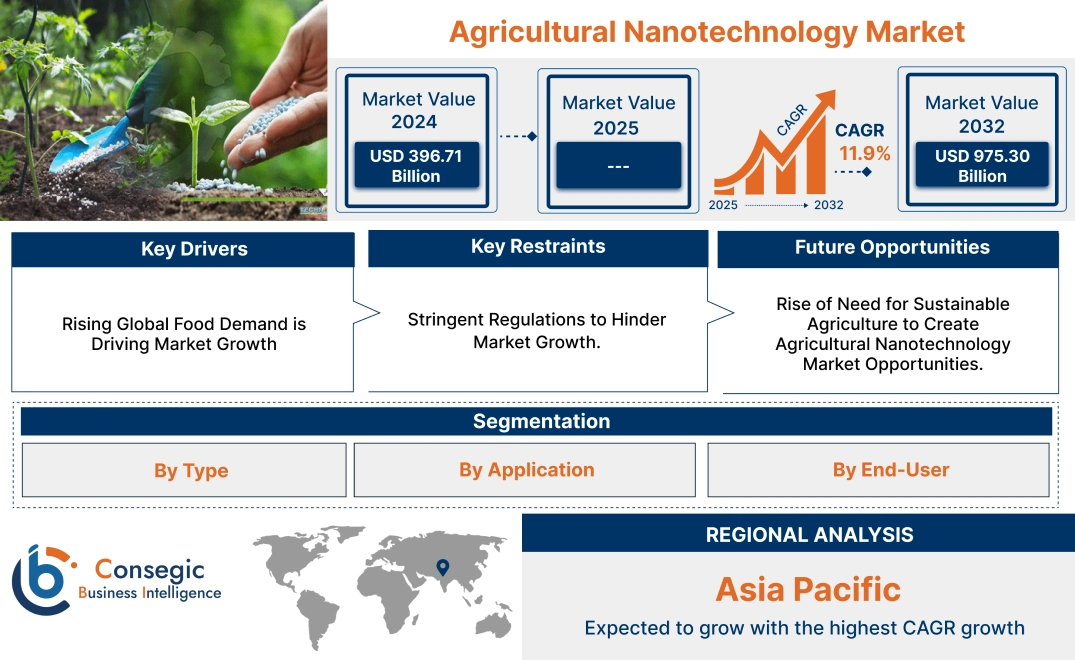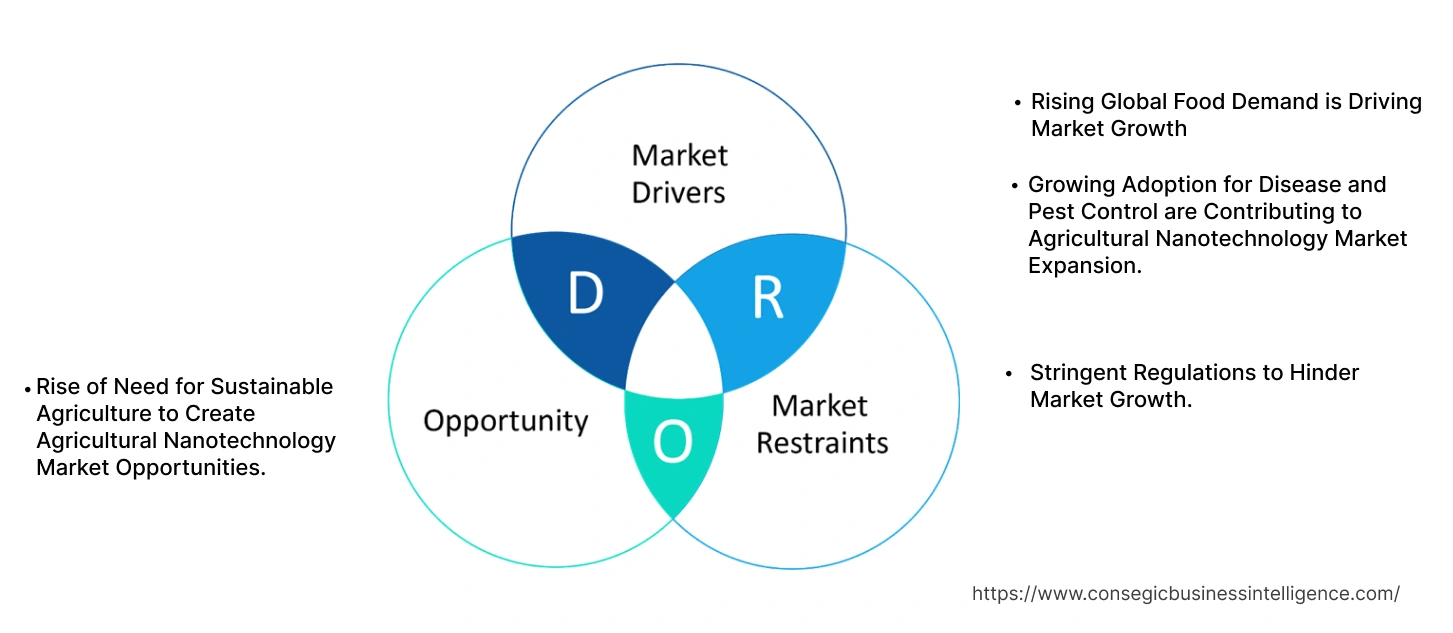- Summary
- Table Of Content
- Methodology
Agricultural Nanotechnology Market Size:
Agricultural Nanotechnology Market size is growing with a CAGR of 11.9% during the forecast period (2025-2032), and the market is projected to be valued at USD 975.30 Billion by 2032 from USD 396.71 Billion in 2024.
Agricultural Nanotechnology Market Scope & Overview:
Nanotechnology is defined as the management of matter at a very minute scale. It offers solutions for the improvement in production of crops, improvement in health of the soil amongst others. A few of the key benefits in agriculture with respect to nanotechnology are the usage of techniques such as development of tailor specific pesticides for certain insects amongst others. In addition to this, nanotechnology also offers innovative solutions to cater to global concerns as well. Climate change is one of these concerns. It caters to climate change by developing rainwater storage that is efficient in nature in soil. Regulatory challenges are some of the factors that need to be taken into consideration to establish sustainable development.
Key Drivers:
Rising Global Food Demand is Driving Market Growth
The increase in global population is directly proportional to the increase in amount of food consumed. In addition to this, changes in consumer preference with respect to dietary habits are leading to an increase the agricultural output.
- For instance, according to Springer Nature Limited, the food demand is expected to increase from approximately 35% to 55% from 2010 to 2050 across the globe.
To cater to this rising requirement, agriculture nanotechnology players are focusing on developing new technologies. In addition to boosting productivity, these technologies contribute to a reduction in production costs. These technologies are expected to have a significant positive impact on the agricultural nanotechnology market growth.
Growing Adoption for Disease and Pest Control are Contributing to Agricultural Nanotechnology Market Expansion.
The growing adoption of nanotechnology for combating diseases and pests is a pivotal factor driving the agricultural nanotechnology market expansion. Nano-pesticides, engineered at the nanoscale, offer precision. This precision provides targeted delivery to specific pests. Simultaneously, it minimizes collateral damage to beneficial insects and the corresponding environment.
- For instance, according to USDA’s National Institute of Food and Agriculture, wastage of global crop production on a yearly basis due to pest is between 20% - 40%.
Furthermore, nanotechnology allows disease management proactively. This is done through the development of nanosensors. These sensors facilitate early detection of diseases and pests. This enables them for timely interventions and minimizing crop losses. As the agricultural is increasingly recognizes the benefits offered by these advancements, the demand for nanotechnology-based solutions for disease and pest control is expected to grow significantly.
Key Restraints:
Stringent Regulations to Hinder Market Growth.
Stringent regulations are important in order to ensure safety and environmental protection. Simultaneously, they also create hurdles for businesses involved in the development of innovative technologies. The process of obtaining regulatory approvals for novel agricultural technologies is time-consuming as well as expensive. It requires testing and thorough documentation. This lengthy approval process leads to delays in the market entry of innovative products. Furthermore, the dynamic nature of these regulations provides uncertainty and risk for businesses. This leads to discouraging investment in new technologies. This uncertainty hinders market entry. Moreover, stringent regulations also restrict the availability of certain technologies in specific markets, thereby limiting their widespread adoption and in turn hindering their commercial success.
Future Opportunities :
Rise of Need for Sustainable Agriculture to Create Agricultural Nanotechnology Market Opportunities.
Traditional agricultural methods often rely on chemical fertilizers and pesticides, leading to harmful environmental consequences. Nanotechnology offers innovative solutions to reduce these impacts. Furthermore, sustainable agriculture emphasizes the efficient utilization of vital resources such as water and land. Additionally, nanotechnology-based sensors monitor soil moisture levels and optimize irrigation schedules, minimizing water wastage.
- For instance, according to AgTech Media Group LLC, it is estimated that USD 260 billion will be invested for sustainable agriculture in developing economies by 2030
Additionally, nanotechnology is necessary in developing crop varieties that exhibit enhanced resilience to the adverse impacts of climate change. The increasing emphasis on sustainable agricultural practices creates a market demand for innovative technologies.
Agricultural Nanotechnology Market Segmental Analysis :
By Type:
Based on Type, the market is categorized into nano-pesticides, nano-fertilizers, nano-biosensors, and others
Trends in the Type:
- The trend for nano-pesticides with enhanced target specificity is influencing the segment.
- Integrating nano-fertilizers with precision agriculture technologies is showcasing agricultural nanotechnology market growth
The nano-pesticide segment accounted for the largest market share in 2024.
- The prevalence of insects, fungi, and weeds creates a significant reduction in crop yields. Due to this there is a strong requirement for effective and efficient pest control solutions.
- Nano-pesticides offer numerous advantages over conventional pesticides, including enhanced target specificity, improved bioavailability, amongst others
- Furthermore, the growing focus on sustainable agricultural practices significantly contributes to the prominence of nano-pesticides. These innovative formulations enable a reduction in the reliance on broad-spectrum pesticides.
- This helps in reducing environmental pollution and promoting more sustainable agricultural practices.
- Hence, as per the market analysis, due to the above-mentioned factors, nano-pesticides currently dominate the market
The nano-fertilizers segment is expected to grow at the fastest CAGR over the forecasted period.
- Nano-fertilizers are engineered to significantly enhance nutrient uptake efficiency by plants, resulting in higher yields while simultaneously reducing the overall fertilizer input required.
- This enhances economic feasibility for farmers and also minimizes environmental pollution. Environmental pollution is reduced by nutrient runoff and leaching.
- Furthermore, a growing awareness among farmers regarding the numerous benefits of nano-fertilizers, including improved crop quality and reduced environmental impact, is driving their increased adoption.
- For instance, in 2024, Iffco got approval from the Indian Government to launch new two nano-technology based fertilizers.
Additionally, as per the agricultural nanotechnology market analysis government support for sustainable agriculture initiatives, along with the development of innovative technologies like nano-fertilizers is creating lucrative agricultural nanotechnology market opportunities.
By Application:
The application segment is categorized into crop production & protection, soil improvement, plant breeding, and others
Trends in the Application:
- The trend in nanotechnology is increasingly integrated with precision agriculture technologies, enabling site-specific application of inputs.
- Nanotechnology-based tools are being used for precise gene editing, enabling the development of crops with enhanced traits.
The crop production & protection segment accounted for the largest market share of 53.22% in 2024 and is expected to grow at the fastest CAGR over the forecast period.
- The increasing global requirement for higher crop yields along with the need to effectively address the challenges of pests and diseases. Nanotechnology authorizes the precise and targeted application of inputs such as fertilizers and pesticides.
- Furthermore, a key focus within this segment is on the development of smart delivery systems for agrochemicals.
- These innovative systems, such as nano-capsules and controlled-release formulations were accurately engineered in order to release agrochemicals. This helps in optimizing their efficacy while simultaneously minimizing environmental harm.
- For instance, in 2023, Aqua-Yield Operations, LLC’s NanoPro became the flagship product called NanoPro. It is used as a carrier adjuvant for applications related to the protection of crops.
- By ensuring that agrochemicals are delivered precisely where and when they are needed, these smart delivery systems contribute to a more sustainable agricultural landscape.
- Thus, as per the market analysis, these factors are influencing segment growth.
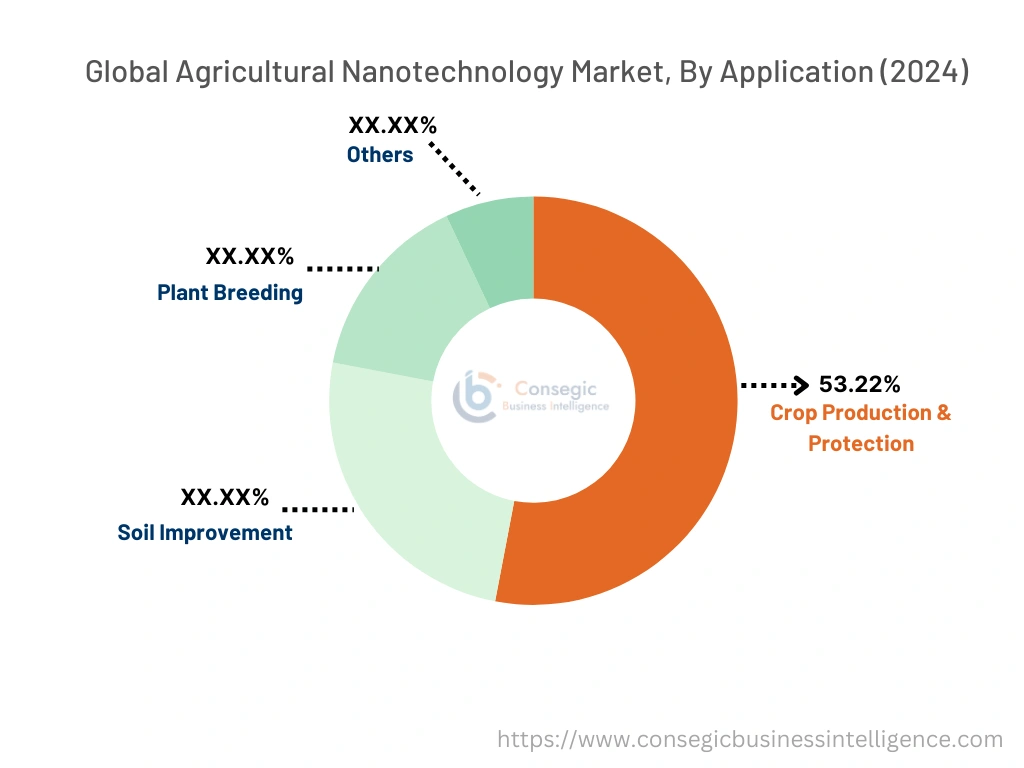
By End-User:
Based on End User, the market is categorized into farmers, research and development institutes, agrochemical companies, and others
Trends in the End User:
- Farmers are increasingly adopting precision agriculture technologies, including GPS-guided equipment, drones amongst others
The farmers segment accounted for the largest market share in 2024.
- Farmers are focusing on precision agriculture technologies for their cultivation. Technologies included are GPS-guided equipment, drones for aerial monitoring, and sensors. These technologies help farmers to get real-time data on soil conditions, and environmental factors.
- By using these technologies, farmers aim to optimize the application of inputs. This helps in maximizing the utilization of resources while minimizing waste.
- Furthermore, farmers are increasingly using data analytics and artificial intelligence to make informed decisions.
- There is a growing requirement for agricultural technologies that are seamlessly integrated into existing farming practices, due to the importance of user-friendliness and affordability.
- This necessitates the development of new nanotechnologies that are both accessible and cost-effective for farmers.
- As per the agricultural nanotechnology market analysis, owing to the above-mentioned factors, farmers are dominating the Agricultural Nanotechnology market trends.
The agrochemical companies segment is expected to grow at the fastest CAGR over the forecast period.
- Agrochemical companies are investing heavily in research and development, to develop innovative products such as biopesticides and biostimulants amongst others.
- Furthermore, companies are increasingly prioritizing the development of environmentally friendly products. This will help to minimize reliance on traditional agrochemicals.
- For instance, Zuari Farmhub Ltd introduced a new nano fertilizer. These fertilizers are named Nano Shakti Nano DAP and Shakti Nano Urea. These nano-fertilizers are planned with applications such as improvement in soil health and crop yield taken into consideration.
- Additionally, agrochemical companies are actively expanding their reach into digital agriculture. They are offering farmers precision farming services amongst others. This strategic diversification not only expands their market reach but also strengthens their position as key players in the evolving agricultural landscape.
- Furthermore, several key agrochemical companies possess strong market positions, and extensive expertise within the agricultural sector.
- As per the market analysis, these factors contribute to the fastest CAGR for agrochemical companies’ segment in the market, thus influencing the trends in the market.
Regional Analysis:
The regional segment includes North America, Europe, Asia Pacific, the Middle East and Africa, and Latin America.
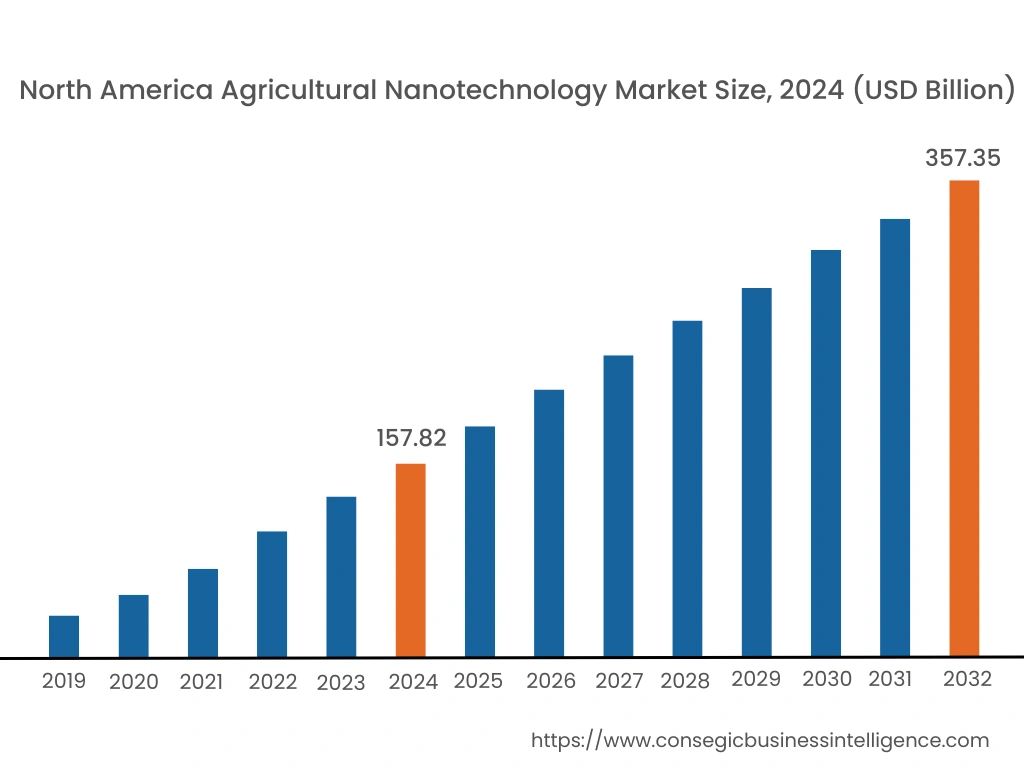
In 2024, North America accounted for the highest agricultural nanotechnology market share at 39.79% and was valued at USD 157.82 Billion and is expected to reach USD 357.35 Billion in 2032. In North America, the U.S. accounted for the agricultural nanotechnology market share of 72.43% during the base year of 2024.
North America currently holds a dominant position in the agricultural nanotechnology industry, driven by several key factors. The region has a high rate of adoption when precision agriculture technologies are taken into consideration. This is improved by the investment in advanced infrastructure along with rising focus on sustainable farming practices.
- For instance, in 2024, Nutrien stated its alliance with Bunge in order to help out the U.S. farmers for incorporating sustainable farming practices. This is to reduce carbon footprint.
Nanotechnology seamlessly integrates with these precision agriculture systems. This enables tailor specific application of nano-fertilizers and nano-pesticides. Hence as per the market analysis, owing to the above-mentioned factors North America is currently dominating the Global Agricultural Nanotechnology Market trends.
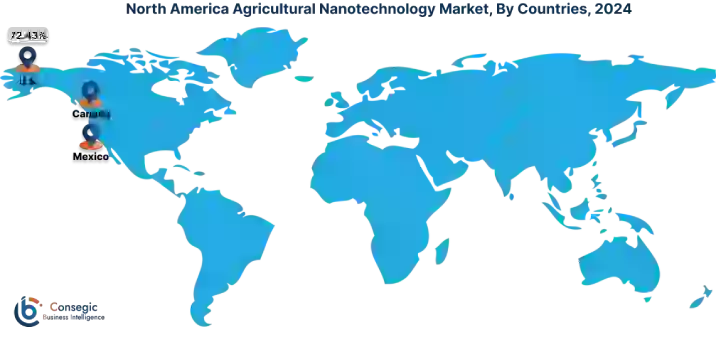
In Asia Pacific, the agricultural nanotechnology industry is experiencing the fastest growth with a CAGR of 13.9% over the forecast period. The region's growing population has led to an increase in the requirement for food to meet their escalating agricultural nanotechnology market demand. This surge in requirement, coupled with limited arable land necessitates innovative solutions to enhance food production while ensuring sustainability. Additionally, the Asia Pacific region suffers with significant challenges. These challenges are posed by a number of pests and diseases. This in turn leads to substantial crop losses. To cater to these challenges, agricultural nanotechnology offers an innovative solutions. By enhancing crop yields, optimizing resource efficiency, nanotechnology plays a crucial role in addressing the food requirement concern within the region. Moreover, due to the increasing disease and pest pressures, nanotechnology has helped farmers with targeted and effective control strategies.
The European region has well-established research institutions. These institutions and universities are actively engaged in nanotechnology research. This fuels the development of new nanomaterials and innovative agricultural applications. Additionally, the European Union plays an important role by introducing a range of supportive policies. These initiatives include substantial funding programs, the establishment of regulatory frameworks amongst others. By promoting collaboration between academia, industry, and government stakeholders, these policies create a favorable environment for edge research into commercially viable products and technologies. This inturn helps in driving the growth of the European agricultural nanotechnology market demand.
The Middle East and African often suffer from issues such as water scarcity. This has led to the increase in requirement for the development of drought-resistant crops, advanced irrigation systems, and technologies that optimize water usage. Additionally, soil degradation, poses a significant threat to agricultural productivity. Nanotechnology offers innovative solutions to improve these issues by enhancing soil fertility and improving water retention capacity. Furthermore, the development of innovative products tailored to the specific needs of these regions is observed. A key focus lies on developing climate-resilient crops that can withstand the impacts of drought, heat stress, and salinity. Nanotechnology offers innovative solutions, including targeted delivery of pesticides, early disease detection systems, amongst others. These factors collectively contribute to the market in Middle East and African regions.
The Latin American market for agricultural nanotechnology is primarily driven by focus on developing smart farming technologies. These technologies are majorly implemented for precision agriculture. Nanotechnology is utilized in the fabric of smart farming. This enables a range of transformative applications. Nanosensors provide real-time data on soil conditions, plant health, amongst others. Furthermore, nanotechnology contributes to the development of robotic vehicles and drones. These help in streamlining agricultural operations such as planting, harvesting, and data collection, enhancing efficiency and minimizing labor costs. Moreover, these smart farming technologies, powered by nanotechnology, are important in addressing the challenges faced by Latin American agriculture. These challenges include reducing the impacts of climate change and improving water use efficiency. This combined focus on developing and implementing smart farming technologies, driven by advancements in nanotechnology, are contributing to the Latin American market for growth over the forecast period.
Top Key Players and Market Share Insights:
The Global Agricultural Nanotechnology Market is highly competitive with major players providing products to the national and international markets. Key players are adopting several strategies in research and development (R&D) and product innovation to hold a strong position in the global Agricultural Nanotechnology market. Key players in the Agricultural Nanotechnology industry include-
- Zyvex (U.S.)
- Oxford Instruments (U.K.)
- ASML (Netherlands)
- CHEMAT TECHNOLOGY INC. (U.S.)
- Integran Technologies (Canada)
- Nanoco Group plc (U.K.)
- ThalesNano Inc. (U.S.)
- eSpin Technologies (U.S.)
- Nanosys Inc. (U.S.)
- LYC North America (U.S.)
Agricultural Nanotechnology Market Report Insights :
| Report Attributes | Report Details |
| Study Timeline | 2019-2032 |
| Market Size in 2032 | USD 975.30 Billion |
| CAGR (2025-2032) | 11.9% |
| By Type |
|
| By Application |
|
| By End-User |
|
| By Region |
|
| Key Players |
|
| North America | U.S. Canada Mexico |
| Europe | U.K. Germany France Spain Italy Russia Benelux Rest of Europe |
| APAC | China South Korea Japan India Australia ASEAN Rest of Asia-Pacific |
| Middle East and Africa | GCC Turkey South Africa Rest of MEA |
| LATAM | Brazil Argentina Chile Rest of LATAM |
| Report Coverage |
|
Key Questions Answered in the Report
How big is the Agricultural Nanotechnology market? +
In 2024, the Agricultural Nanotechnology market is USD 396.71 Billion.
Which is the fastest-growing region in the Agricultural Nanotechnology market? +
Asia Pacific is the fastest-growing region in the Agricultural Nanotechnology market.
What specific segmentation details are covered in the Agricultural Nanotechnology market? +
By Type, Application and End User segmentation details are covered in the Agricultural Nanotechnology market.
Who are the major players in the Agricultural Nanotechnology market? +
Zyvex (U.S.), Oxford Instruments (U.K.), Nanoco Group plc (U.K.), ThalesNano Inc. (U.S.) are some of the major players in the market.
